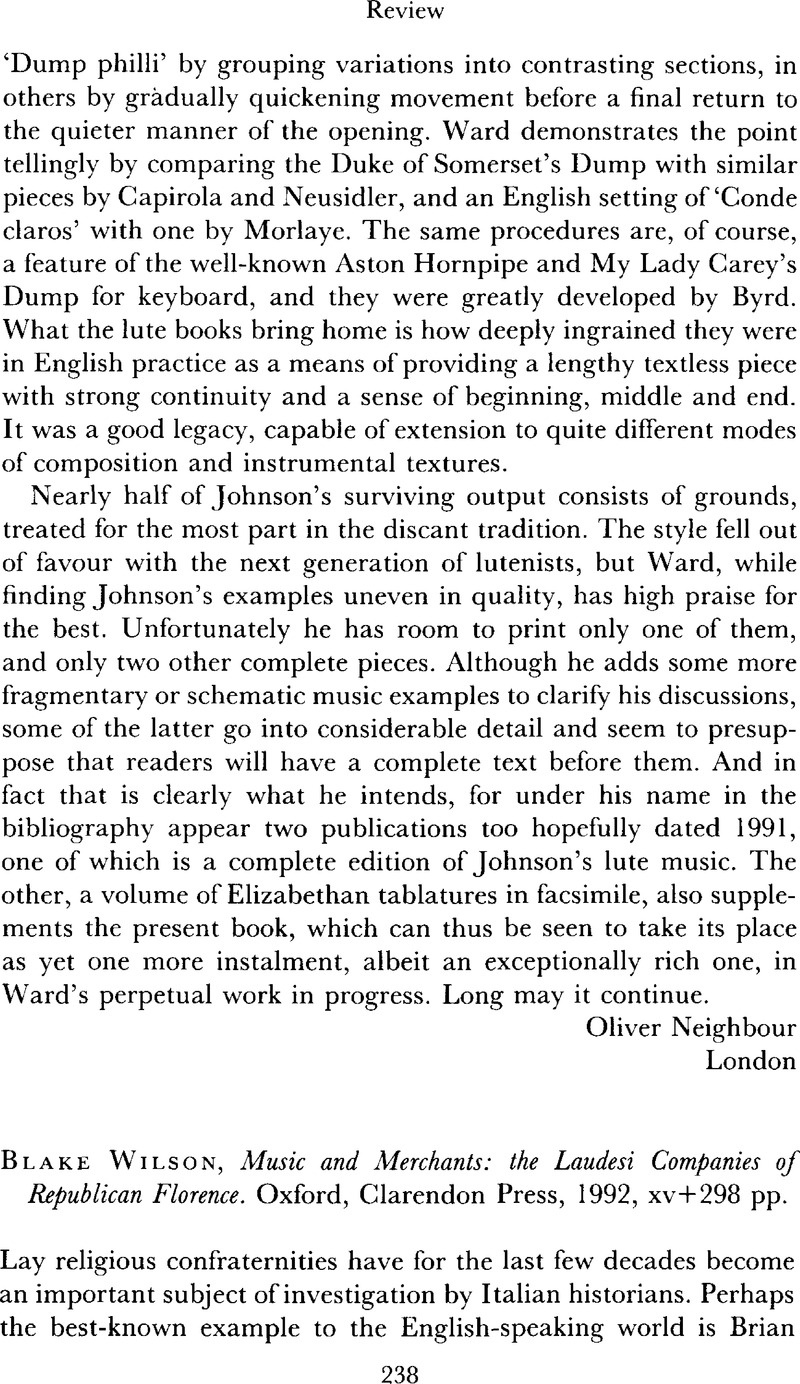No CrossRef data available.
Article contents
Blake Wilson, Music and Merchants: the Laudesi Companies of Republican Florence. Oxford, Clarendon Press, 1992, xv+298 pp.
Published online by Cambridge University Press: 05 December 2008
Abstract

- Type
- Reviews
- Information
- Copyright
- Copyright © Cambridge University Press 1993
References
1 Pullan, B., Rich and Poor in Renaissance Venice: the Social Institutions of a Catholic State to 1620 (Oxford, 1971)Google Scholar; Meersseman, G. G., Ordo fraternitatis: confraternite e pietà dei laici nel medioevo (Rome, 1977)Google Scholar; Weissman, R. F. E., Ritual Brotherhood in Renaissance Florence (New York, and London, 1982)Google Scholar; Henderson, J., ‘Piety and Charity in Late Medieval Florence’ (Ph.D. dissertation, University of London, 1983)Google Scholar, and now under the same title (Oxford, 1993); Mackenney, R., Tradesman and Traders: the World of the Guilds in Venice and Europe, c. 1250–c. 1650 (London, 1987).Google Scholar
2 Fiorani, L., ed., ‘Le confraternite romane: esperienza religiosa, società, committenza artistica’, Ricerche Storiche per la Storia di Roma, 5 (1984)Google Scholar; Le mouvement confraternel au moyenâge: France, Italie, Suisse, Collection de l'École Française de Rome 97 (Rome, 1987)Google Scholar; Verdon, T. V. and Henderson, J., eds., Christianity and the Renaissance (Syracuse, NY, 1990), part 2.Google Scholar
3 Brown, P. Fortini, Venetian Narrative Painting in the Age of Carpaccio (New Haven and London, 1988)Google Scholar; Edgerton, S., Pictures and Punishment: Art and Criminal Procedure during the Florentine Renaissance (Ithaca and London, 1985).Google Scholar
4 See the classic d'Ancona, A., Origini del teatro italiano (Turin, 1891 edn)Google Scholar, but more recently Newbigin, N., ed., Nuovo corpus di sacre rappresentazioni fiorentini del Quattrocento (Bologna, 1983)Google Scholar, and Barr, C., ‘Music and Spectacle in Confraternity Drama of Fifteenth-Century Florence: the Reconstruction of a Theatrical Event’, in Christianity and the Renaissance, ed. Verdon, and Henderson, , pp. 376–404.Google Scholar
5 Pirrotta, N., Music and Culture in Italy from the Middle Ages to the Baroque (Cambridge, 1984)CrossRefGoogle Scholar, and Cattin, G., Music of the Middle Ages (Cambridge, 1986)Google Scholar; Barr, C., The Monophonic Lauda and the Lay Religious Confraternities of Tuscany and Umbria in the Late Middle Ages (Kalamazoo, MI, 1988)Google Scholar; D'Accone, F., ‘Alcune note sulle compagnie fiorentine dei laudesi durante il Quattrocento’, Rivista Italiana di Musicologia, 10 (1967), pp. 38–76 Google Scholar, and ‘Le compagnie dei laudesi durante l'Ars Nova’, L'Ars nova italiana del Trecento (Certaldo, 1970), pp. 253–80.Google Scholar
6 Rosenwein, B. and Little, L. K., ‘Social Meaning in the Monastic and Mendicant Spiritualities’, Past and Present, 63 (1974), pp. 4–32 CrossRefGoogle Scholar; Little, L. K., Religious Poverty and the Profit Economy in Medieval Europe (London, 1978)Google Scholar; and on the Florentine context: Lesnick, L. R., ‘Dominican Preaching and the Creation of a Capitalist Ideology in Late-Medieval Florence’, Memorie Domenicane, new ser., 8–9 (1977–8), pp. 199–247.Google Scholar See more recently for some salutary remarks on this theme: D'Avray, D., The Preaching of the Eriars: Sermons diffused from Paris before 1300 (Oxford, 1985), pp. 217–19.Google Scholar
7 Weissman, , Ritual Brotherhood, pp. 37, 163–4.Google Scholar
8 Cf. the articles of D'Accone mentioned above and Henderson, Piety and Charity, ch. 3.
9 See Kent, D., ‘The Buonomini di S. Martino: Charity for the “glory of god, the honour of the city, and the commemoration of myself”’, in Cosimo ‘il Vecchio’ de' Medici, 1389–1464, ed. Ames-Lewis, F. (Oxford, 1992), pp. 49–67.Google Scholar
10 See Henderson, , Piety and Charity, ch. 10.Google Scholar
11 Weissman, , Ritual Brotherhood, ch. 6Google Scholar; Black, C. F., Italian Confraternities in the Sixteenth Century (Cambridge, 1989).Google Scholar


